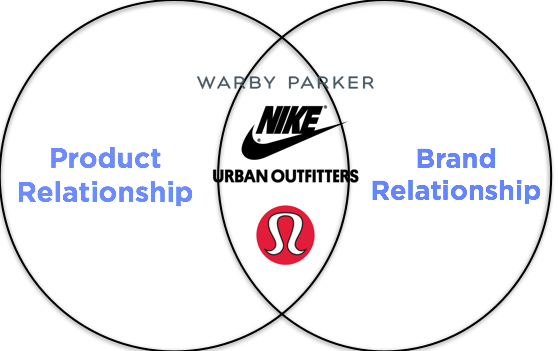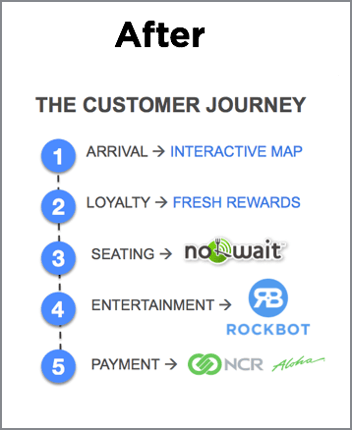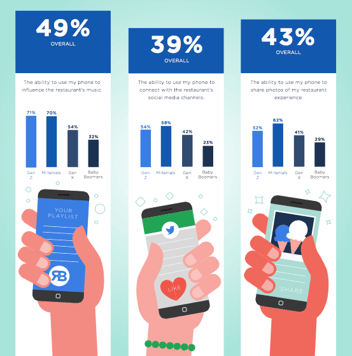Warby Parker, Urban Outfitters, Lululemon, Nike. All of these brands have something in common.
They are driving customers through the door and not using their product to it.
Customers will always have a positive or negative relationship with your product, but what if they could also build a relationship with your brand? The above brands are making this happen by blurring the line where customers have both a product relationship and a brand relationship through other means. In an age where it's more common to text someone than pick up the phone to call them and where popularity in mobile usage has brought retail right to your finger tips, it's become more and more important to create an environment people can't get with the click of a mouse or a swipe of the thumb. This means incorporating music, digital screens, free space for events and other interactive experiences to engage and entertain your customers beyond traditional means.
Let's take a look at the four retailers above to see how they are doing this:
Warby Parker: Known for their eye glasses and a unique "try it before you buy it" business model, Warby Parker puts a lot of hard work into their store experience. Their flagship store in NYC is a great example of this. Complete with a photobooth and makeshift library, their Green St. store has a stately finish and fits with their ideals as a brand. It makes sense that they would sell books, given they're selling eyeglasses to help you read them. Recently, Warby Parker has also started to promote their musical tastes, pushing their Spotify playlists in emails to engage their customers in ways that are easily relateable. They have holiday playlists as well as in store music posted on their account and have over 600 followers.
Urban Outfitters: This retail giant has been all over the news lately because of their recent partnership with restaurateur, Marc Vetri. Urban's Chief Development Officer, Dave Ziel, stated the reason for the purchase was filling a social void. He explains, "We think retailing needs to become more experiential... I think there's a craving for real socializing beyond social media." Creating retail experiences for their customers has been a huge push for Urban Outfitters since the beginning of 2015. The real benefit? Their target market, millennials, have been increasing the amount they spend on food year over year. Aside from clothing, Urban Outfitters also sells records and actually plays much of the same music they sell in their store over the loud speaker. Giving their customers another way to identify with their brand. They promote music on their blog and you can find their SoundCloud page here.
Nike: Over the years, Nike has done a number of different things to allow customers to experience their brand within stores. Their 2 main differentiators are the Nike Brand Experience Stores and the Nike Community Stores, each with different goals and ways to interact with the community. From their news article, the Community Store's mission is to, "build and empower a healthy local community through the unifying power of sport and to serve as a catalyst for positive change in each area a store is located." They aim to hire most employees within a five mile radius of the store, provide training so that they can deliver sports programming for kids within the community and enable them to award grants to organizations within their communities. Nike's Brand Experience Stores are a little different. They go far beyond their product line, offering differentiated services, presentations and product testing in a space much larger than their normal retail stores. They host Nike+ Run Club Challenges featuring workout, music and general health tips. Their various types of Experience Stores include things like product categories key to the area they are located in, special venue space that could be used for events or workout classes and an overall different way to interact with the product that tells a story around how it was originated and why.
LuluLemon: Like everyone mentioned above, the experience at LuluLemon is not just product focused. They focus on creating routine community events such as weekly yoga classes. They also make connections with community ambassadors and the local fitness instructors who can be found talking to customers about healthy living, excercise etc. In fact, this emphasis on experience began with their first store which shared its retail space with a yoga studio. Now, their fixtures have become more modular allowing for flexibility within the space for different activities. To boost community building, they also have been implementing interactive mirrors in their stores which connects shoppers with local eateries, fitness classes and various events happening within the community. They even bring in DJ's to spin in store music for their customers during big community events. Much of Lululemon's store experience isn't pushing consumers towards the product, it's pushing consumers towards a healthy community.
So, what can we learn from these four retailers? They are trying hard to understand their customers and incorporating the things they care about into their brand marketing. They are trying to create other layers for customer interaction beyond their product and customers are responding to it. Whether it's through community service, food, in store music or physical activity, your brand can be a multi-dimensional tool for you to drive more business and create a happy network of customers!
Need music for your retail environment? Rockbot provides customizable in store music for your brand. Learn more below:







